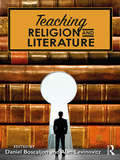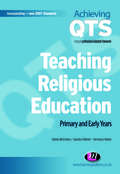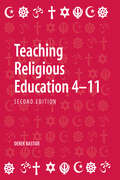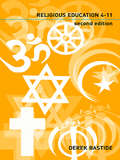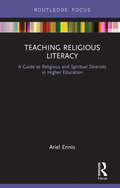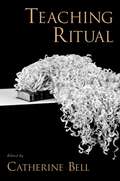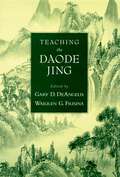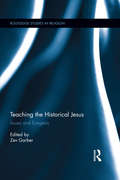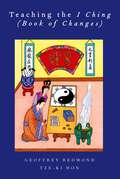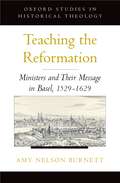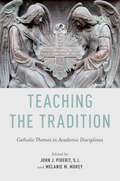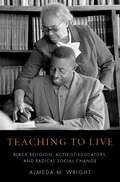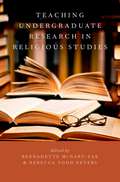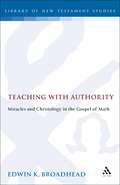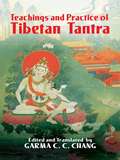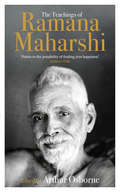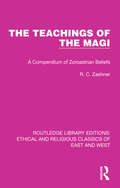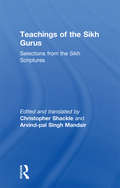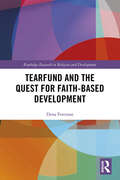- Table View
- List View
Teaching Religion and Literature
by Daniel Boscaljon Alan LevinovitzTeaching Religion and Literature provides a practical engagement with the pedagogical possibilities of teaching religion courses using literature, teaching literature classes using religion, and teaching Religion and Literature as a discipline. Featuring chapters written by award winning teachers from a variety of institutional settings, the book gives anyone interested in providing interdisciplinary education a set of questions, resources, and tools that will deepen a classroom’s engagement with the field. Chapters are grounded in specific texts and religious questions but are oriented toward engaging general pedagogical issues that allow each chapter to improve any instructor’s engagement with interdisciplinary education. The book offers resources to instructors new to teaching Religion and Literature and provides definitions of what the field means from senior scholars in the field. Featuring a wide range of religious traditions, genres, and approaches, the book also provides an innovative glimpse at emerging possibilities for the sub-discipline.
Teaching Religion and Literature
by Daniel Boscaljon Alan LevinovitzTeaching Religion and Literature provides a practical engagement with the pedagogical possibilities of teaching religion courses using literature, teaching literature classes using religion, and teaching Religion and Literature as a discipline. Featuring chapters written by award winning teachers from a variety of institutional settings, the book gives anyone interested in providing interdisciplinary education a set of questions, resources, and tools that will deepen a classroom’s engagement with the field. Chapters are grounded in specific texts and religious questions but are oriented toward engaging general pedagogical issues that allow each chapter to improve any instructor’s engagement with interdisciplinary education. The book offers resources to instructors new to teaching Religion and Literature and provides definitions of what the field means from senior scholars in the field. Featuring a wide range of religious traditions, genres, and approaches, the book also provides an innovative glimpse at emerging possibilities for the sub-discipline.
Teaching Religious Education
by Elaine Mccreery Sandra Palmer Veronica VoielsMany trainee primary teachers are uncertain as to the place and purpose of RE in primary schools. This book is designed to alleviate such fears and give trainees the security and confidence to teach RE effectively. Trainees are encouraged to recognise their own religious position and understand how they handle their own beliefs and commitments in the classroom. In addition, they will learn how to be sensitive to children's religious viewpoints, allowing children to share their beliefs in a secure and supportive environment. A range of strategies help readers to provide engaging and appropriate RE across the primary age phase.
Teaching Religious Education 4-11
by Derek BastideThis long-awaited second edition is an accessible, practical guide for primary teachers. It covers the teaching of religious education at the Foundation Stage, Key Stage 1 and Key Stage 2. Taking account of the changes to RE over the last decade, it maps out and considers the implications for teachers of: changes that have taken place over the last few years with regard to changing aims and objectives in the subject the legal framework the broadening understanding of the notion of religion concern for spiritual development emergence of citizenship as an additional component of the curriculum introduction of formal guidelines to the content of RE teaching Christianity and other world faiths tackling important topics and contemporary issues planning RE across the primary school planning a unit of work using different teaching approaches monitoring and assessing progress. The book is full of practical examples and will also contain a uesful resources section. In addition there will be a chapter on key religions, which will look at Buddhism, Christianity, Hinduism, Islam, Judaism and Sikhism.
Teaching Religious Education 4-11
by Derek BastideThis long-awaited second edition is an accessible, practical guide for primary teachers. It covers the teaching of religious education at the Foundation Stage, Key Stage 1 and Key Stage 2. Taking account of the changes to RE over the last decade, it maps out and considers the implications for teachers of: changes that have taken place over the last few years with regard to changing aims and objectives in the subject the legal framework the broadening understanding of the notion of religion concern for spiritual development emergence of citizenship as an additional component of the curriculum introduction of formal guidelines to the content of RE teaching Christianity and other world faiths tackling important topics and contemporary issues planning RE across the primary school planning a unit of work using different teaching approaches monitoring and assessing progress. The book is full of practical examples and will also contain a uesful resources section. In addition there will be a chapter on key religions, which will look at Buddhism, Christianity, Hinduism, Islam, Judaism and Sikhism.
Teaching Religious Literacy: A Guide to Religious and Spiritual Diversity in Higher Education
by Ariel EnnisOffering resources and initiatives on religious and spiritual diversity in higher education, this book describes the conceptual foundations for teaching religious literacy and provides a sample curriculum with a facilitator's guide and assessment tools needed to evaluate its development among students. With a clear understanding of the diversity of religious and spiritual experiences found on college and university campuses, Ennis offers a much-needed framework for facilitating conversations about religion and spirituality in colleges and universities. By working from a comprehensive overview of NYU’s award-winning Faith Zone training program, this book breaks down the methodology and tools required to create religious literacy training curricula at campuses around the world.
Teaching Religious Literacy: A Guide to Religious and Spiritual Diversity in Higher Education
by Ariel EnnisOffering resources and initiatives on religious and spiritual diversity in higher education, this book describes the conceptual foundations for teaching religious literacy and provides a sample curriculum with a facilitator's guide and assessment tools needed to evaluate its development among students. With a clear understanding of the diversity of religious and spiritual experiences found on college and university campuses, Ennis offers a much-needed framework for facilitating conversations about religion and spirituality in colleges and universities. By working from a comprehensive overview of NYU’s award-winning Faith Zone training program, this book breaks down the methodology and tools required to create religious literacy training curricula at campuses around the world.
Teaching Ritual (AAR Teaching Religious Studies)
by Catherine BellThere is a great deal of interest in bringing a better appreciation of ritual into religious studies classes, but many teachers are uncertain how to go about doing this. Religious studies faculty know how to teach texts, but they are often unprepared to teach something for which the meaning lies in the doing. How much doing should a class do? How does the teacher talk about religious concepts that exist in practical relationships, not textual descriptions? These practical issues also give rise to theoretical questions. Giving more attention to ritual effectively suggests a reinterpretation of religion itselfless focused on what people have thought and written, and more focused on how they order their universe. Much of the useful analysis of ritual derives from anthropological and sociological premises, which are often foreign to religious studies faculty and are seen by some as theologically problematic. This is the first resource to address the issues specific to teaching this subject. A stellar cast of contributors, who teach ritual in a wide variety of courses and settings, explain what has worked for them in the classroom, what hasn't, and what they've learned from experience. Their voices range from personal to formal, and their topics from Japanese theatre to using field trips. The result is a thoughtful guide for teachers who are new to the subject as well as experienced ones looking for fresh angles and approaches.
Teaching the Daode Jing (AAR Teaching Religious Studies)
by Gary Delaney DeAngelis Warren G. FrisinaThe Daode Jing, a highly enigmatic work rooted in ancient Chinese cosmology, ontology, metaphysics, and moral thinking, is regularly offered to college and high-school students in religion, philosophy, history, literature, Asian studies, and humanities courses. As a result, an ever-expanding group of faculty with very different backgrounds and training routinely confront the question: "How should I teach the Daode Jing?" Written for non-specialists who may not have a background in ancient Chinese culture, the essays collected in this volume provide up-to-date information on contemporary scholarship and classroom strategies that have been successful in a variety of teaching environments. A classic text like the Daode Jing generates debate among scholars and teachers who ask questions like: Should we capitalize on popular interest in the Daode Jing in our classrooms? Which of the many translations and scholarly approaches ought we to use? Is it appropriate to think of the Daode Jing as a religious text at all? These and other controversies are addressed in this volume. Contributors are well-known scholars of Daoism, including Livia Kohn, Norman Girardot, Robert Henricks, Russell Kirkland, Hans-Georg Moeller, Hall Roth, and Michael LaFargue. In addition, there are essays by Eva Wong (Daoist practitioner), David Hall (philosophy), Gary DeAngelis (mysticism), and a jointly written essay on pedagogical strategies by Judith Berling, Geoffrey Foy, and John Thompson (Chinese religion).
Teaching the Historical Jesus: Issues and Exegesis (Routledge Studies in Religion)
by Zev GarberTeaching the Historical Jesus in his Jewish context to students of varied religious backgrounds presents instructors with not only challenges, but also opportunities to sustain interfaith dialogue and foster mutual understanding and respect. This new collection explores these challenges and opportunities, gathering together experiential lessons drawn from teaching Jesus in a wide variety of settings—from the public, secular two- or four-year college, to the Jesuit university, to the Rabbinic school or seminary, to the orthodox, religious Israeli university. A diverse group of Jewish and Christian scholars reflect on their own classroom experiences and explicates crucial issues for teaching Jesus in a way that encourages students at every level to enter into an encounter with the Hebrew Scriptures and the New Testament without paternalism, parochialism, or prejudice. This volume is a valuable resource for instructors and graduate students interested in an interfaith approach in the classroom, and provides practical case studies for scholars working on Jewish-Christian relations.
Teaching the Historical Jesus: Issues and Exegesis (Routledge Studies in Religion)
by Zev GarberTeaching the Historical Jesus in his Jewish context to students of varied religious backgrounds presents instructors with not only challenges, but also opportunities to sustain interfaith dialogue and foster mutual understanding and respect. This new collection explores these challenges and opportunities, gathering together experiential lessons drawn from teaching Jesus in a wide variety of settings—from the public, secular two- or four-year college, to the Jesuit university, to the Rabbinic school or seminary, to the orthodox, religious Israeli university. A diverse group of Jewish and Christian scholars reflect on their own classroom experiences and explicates crucial issues for teaching Jesus in a way that encourages students at every level to enter into an encounter with the Hebrew Scriptures and the New Testament without paternalism, parochialism, or prejudice. This volume is a valuable resource for instructors and graduate students interested in an interfaith approach in the classroom, and provides practical case studies for scholars working on Jewish-Christian relations.
Teaching the I Ching (AAR Teaching Religious Studies)
by Geoffrey Redmond Tze-Ki HonChinese traditional culture cannot be understood without some familiarity with the I Ching, yet it is one of the most difficult of the world's ancient classics. Assembled from fragments with many obscure allusions, it was the subject of ingenious, but often conflicting, interpretations over nearly three thousand years. Teaching the I Ching (Book of Changes) offers a comprehensive study at a time when interest in Asian philosophy and the culture of China is on the rise. Still widely read in China, it has become a countercultural classic in the West. Recent scholarship has radically altered our understanding of this foundational work. Geoffrey Redmond and Tze-Ki Hon present an up-to-date survey of recent studies including reconstruction of the early meanings, excavated manuscripts, the New Culture Movement, and the Cultural Revolution. To facilitate introducing the classic to students, the necessary background is provided for university teachers and students, even non-China specialists. The teaching approaches described will foreground the otherness of the classic, yet engage the interests of twenty-first-century students. Rather than dismissing the text's popular association with divination, they explain why this mode of human thought has persisted for millennia. Thus, Redmond and Hon mediate between the two extreme views of the classic: a source of timeless ancient wisdom on the one hand, and a historical curiosity on the other. Teaching the I Ching (Book of Changes) makes this important classic accessible to a broad readership, thus providing a crucial service for those interested in China, early civilization, and world religion. Now anyone with a serious interest can understand a text that continues to have a decisive influence on Chinese and world culture three thousand years after its original composition.
Teaching the Reformation: Ministers and Their Message in Basel, 1529-1629 (Oxford Studies in Historical Theology)
by Amy Nelson BurnettThough the Reformation was sparked by the actions of Martn Luther, it was not a decisive break from the Church in Rome but rather a gradual process of religious and social change. As the men responsible for religious instruction and moral oversight at the village level, parish pastors played a key role in the implementation of the Reformation and the gradual development of a Protestant religious culture, but their ministry has seldom been examined in the light of how they were prepared for the pastorate. Teaching the Reformation examines the four generations of Reformed pastors who served the church of Basel in the century after the Reformation, focusing on the evolution of pastoral training and Reformed theology, the theory and practice of preaching, and the performance of pastoral care in both urban and rural parishes. It looks at how these pastors were educated and what they learned, examining not only the study of theology but also the general education in languages, rhetoric and dialectic that future pastors received at the citys Latin school and in the arts faculty of the university. It points to significant changes over time in the content of that education, which in turn separated Basels pastors into distinct generations. The study also looks more specifically at preaching in Basel, demonstrating how the evolution of dialectic and rhetoric instruction, and particularly the spread of Ramism, led to changes in both exegetical method and homiletics. These developments, combined with the gradual elaboration of Reformed theology, resulted in a distinctive style of Reformed Orthodox preaching in Basel. The development of pastoral education also had a direct impact on how Basels clergy carried out their other dutiescatechization, administering the sacraments, counseling the dying and consoling the bereaved, and overseeing the moral conduct of their parishioners. The growing professionalization of the clergy, the result of more intensive education and more stringent supervision, contributed to the gradual implantation of a Reformed religious culture in Basel.
Teaching the Tradition: Catholic Themes in Academic Disciplines
by John J. Piderit Melanie M. MoreyThe Catholic intellectual tradition is broad, and covers a wide array of academic disciplines. In their book, John Piderit, Melanie Morey, and their contributors take a disciplinary approach to the Catholic intellectual tradition. Each chapter focuses on one academic discipline or major that is taught at the undergraduate level in most colleges or universities, including English literature, political theory, psychology, business economics, and law.
Teaching to Live: Black Religion, Activist-Educators, and Radical Social Change
by Almeda M. WrightTeaching to Live: Black Religion, Activist-Educators, and Radical Social Change interrogates the stories of African American activist-educators whose faith convictions inspired them to educate in radical and transformative ways. Many of these educators are known only or primarily for their educational theory or activism, and their religious convictions have often been obscured or outright ignored. Almeda M. Wright seeks to rectify this omission, exploring the connections between religion, education, and struggles for freedom within twentieth-century African American communities by telling the stories of key African American teachers. Wright brings together the lives and work of three related subgroups of activist-educators: those who worked in public or secular education but were religiously inspired; radical scholars who transformed the ways that Black religion and Black religious life are studied and valued; and radical religious educators, or those educators who were involved more formally with the religious formation of Black people but who regarded this work of spiritual development as part of the struggle for freedom and liberation of all people. She begins with the reflections of Anna Julia Cooper, W. E. B. Du Bois, Ida B. Wells, and Nannie Helen Burroughs, who attempted to transform American society by expanding the involvement of African Americans as contributors to all aspects of American life, especially the religious, intellectual, and cultural spheres. Wright also examines the activist-educators at the center of the mid-twentieth-century Civil Rights Movement, such as the religious and lay leaders Septima Clark and James Lawson, and the cadre of student leaders and teachers they trained. Finally, she investigates how the models of religious activist-educators Olivia Pearl Stokes and Albert Cleage emerged in the last quarter of the twentieth century at the same time that questions about the centrality of Black Christianity in the African American community and Black activism began to take shape. The rich and complex narratives of these educators show how religion, education, and radical social change can intersect. This book invites readers to continue exploring how these concepts will evolve for future generations of activist-educators.
Teaching to Live: Black Religion, Activist-Educators, and Radical Social Change
by Almeda M. WrightTeaching to Live: Black Religion, Activist-Educators, and Radical Social Change interrogates the stories of African American activist-educators whose faith convictions inspired them to educate in radical and transformative ways. Many of these educators are known only or primarily for their educational theory or activism, and their religious convictions have often been obscured or outright ignored. Almeda M. Wright seeks to rectify this omission, exploring the connections between religion, education, and struggles for freedom within twentieth-century African American communities by telling the stories of key African American teachers. Wright brings together the lives and work of three related subgroups of activist-educators: those who worked in public or secular education but were religiously inspired; radical scholars who transformed the ways that Black religion and Black religious life are studied and valued; and radical religious educators, or those educators who were involved more formally with the religious formation of Black people but who regarded this work of spiritual development as part of the struggle for freedom and liberation of all people. She begins with the reflections of Anna Julia Cooper, W. E. B. Du Bois, Ida B. Wells, and Nannie Helen Burroughs, who attempted to transform American society by expanding the involvement of African Americans as contributors to all aspects of American life, especially the religious, intellectual, and cultural spheres. Wright also examines the activist-educators at the center of the mid-twentieth-century Civil Rights Movement, such as the religious and lay leaders Septima Clark and James Lawson, and the cadre of student leaders and teachers they trained. Finally, she investigates how the models of religious activist-educators Olivia Pearl Stokes and Albert Cleage emerged in the last quarter of the twentieth century at the same time that questions about the centrality of Black Christianity in the African American community and Black activism began to take shape. The rich and complex narratives of these educators show how religion, education, and radical social change can intersect. This book invites readers to continue exploring how these concepts will evolve for future generations of activist-educators.
Teaching Undergraduate Research in Religious Studies (AAR Teaching Religious Studies)
by Bernadette McNary-Zak Rebecca Todd PetersTeaching Undergraduate Research in Religious Studies offers an introduction to the philosophy and practice of Undergraduate Research in Religious Studies and takes up several significant ongoing questions related to it. For those new to Undergraduate Research, it provides an overview of fundamental issues and pedagogical questions and practical models for application in the classroom. For seasoned mentors, the book acts as a dialogue partner on emerging issues and offers insight into pertinent questions in the field based on experience of recognized experts.
Teaching with Authority: Miracles and Christology in the Gospel of Mark (The Library of New Testament Studies #74)
by Edwin K. BroadheadThe foundational inquiries into the relationship of miracles and Christology by Wrede, Dibelius, Bultmann and Marxsen guided a productive half-century of critical research. Their work raised crucial issues concerning the nature of the Gospels and the proper methods of interpretation that have in many ways charted the direction for New Testament studies. A new principle is now to be added to their criteria, however, that strategies of interpretation must be consciously shaped to highlight the features of narrative and its christological focus. The author then employs a consistent narrative strategy of interpretation in order to re-evaluate the relation of miracles and Christology in the Gospel of Mark. The primary goal is reconsideration of the role played by miracle stories in the characterization of Jesus. In particular, the tension posed by recent scholarship between the Jesus of the miracles and the Jesus of the cross is shown to be a false dichotomy.
Teachings and Practice of Tibetan Tantra
by John C. Wilson Garma C. ChangA lifestyle and way of acknowledging one's sensual and spiritual self, Tantric Buddhism preaches the satisfaction of all desires. Step-by-step instructions demonstrate how to perform traditional yoga exercises and provide practical applications for expanding and liberating one's consciousness. Essentially an explanation of surrendering all mental, emotional, and cultural conditionings, the concise guide describes the art of spiritualizing one's sexuality and at the same time offers efficient methods for transmuting fear and attachment into love and universal power.
The Teachings of Ramana Maharshi (The Classic Collection)
by Arthur OsborneSri Ramana Maharshi is widely thought of as one of the most outstanding Indian spiritual leaders of recent times. Having attained enlightenment at the age of 16, he was drawn to the holy mountain of Arunachala in southern India, and remained there for the rest of his life. Attracted by his stillness, quietness and teachings, thousands sought his guidance on issues ranging from the nature of God to daily life.This book brings together many of the conversations Maharshi had with his followers in an intimate portrait of his beliefs and teachings. Through these conversations, readers will discover Maharshi's simple discipline of self-enquiry: knowing oneself and looking inwards as the road to true understanding and enlightenment. This updated edition will appeal to anyone looking for peace, self-awareness, and guidance on how to embrace the self for well being and calm.
The Teachings of the Magi: A Compendium of Zoroastrian Beliefs (Ethical and Religious Classics of East and West #10)
by R. C. ZaehnerOriginally published in 1956, this book provides a clear, scholarly, introduction to the main tenets of Zoroastrian dualism presented largely in the words of the Zoroastrian texts themselves. The book demonstrates the essential reasonableness of Zoroastrian dualism, which is the dualism of a good and an evil spirit, and to show what the means in everyday life and how it is philosophically justified. There are chapters on cosmology, the relation of man to God, the nature of religion, ethics, sacraments and sacrifice, the soul’s fate at death and eschatology.
The Teachings of the Magi: A Compendium of Zoroastrian Beliefs (Ethical and Religious Classics of East and West #10)
by R. C. ZaehnerOriginally published in 1956, this book provides a clear, scholarly, introduction to the main tenets of Zoroastrian dualism presented largely in the words of the Zoroastrian texts themselves. The book demonstrates the essential reasonableness of Zoroastrian dualism, which is the dualism of a good and an evil spirit, and to show what the means in everyday life and how it is philosophically justified. There are chapters on cosmology, the relation of man to God, the nature of religion, ethics, sacraments and sacrifice, the soul’s fate at death and eschatology.
Teachings of the Sikh Gurus: Selections from the Sikh Scriptures
by Christopher Shackle Arvind MandairRecognized masterpieces of Indian literature, the Guru Granth Sahib and the Dasam Granth are fundamental to the Sikh religion, not only in the physical layout of temples and in ceremonies of worship, but as infallible reference texts offering counsel and instruction. Teachings of the Sikh Gurus presents a brand new selection of key passages from these sacred scriptures, translated into modern English by leading experts, Christopher Shackle and Arvind-pal Singh Mandair. Including six longer compositions and many shorter hymns thematically organised by topics such as Time and Impermanence, Self and Mind, Authority, and Ethics, the book’s accessible and carefully chosen extracts distil the essence of Sikhism’s remarkable textual and intellectual legacy, depicting how its message of universal tolerance suits the contemporary world. The detailed introduction and notes to the translations aid readers’ comprehension of the hymns’ form and content, as well as providing some historical context, making it an ideal introduction to Sikh literature.
Teachings of the Sikh Gurus: Selections from the Sikh Scriptures
by Christopher Shackle Arvind MandairRecognized masterpieces of Indian literature, the Guru Granth Sahib and the Dasam Granth are fundamental to the Sikh religion, not only in the physical layout of temples and in ceremonies of worship, but as infallible reference texts offering counsel and instruction. Teachings of the Sikh Gurus presents a brand new selection of key passages from these sacred scriptures, translated into modern English by leading experts, Christopher Shackle and Arvind-pal Singh Mandair. Including six longer compositions and many shorter hymns thematically organised by topics such as Time and Impermanence, Self and Mind, Authority, and Ethics, the book’s accessible and carefully chosen extracts distil the essence of Sikhism’s remarkable textual and intellectual legacy, depicting how its message of universal tolerance suits the contemporary world. The detailed introduction and notes to the translations aid readers’ comprehension of the hymns’ form and content, as well as providing some historical context, making it an ideal introduction to Sikh literature.
Tearfund and the Quest for Faith-Based Development (Routledge Research in Religion and Development)
by Dena FreemanThis book gives an in-depth analysis of the role of faith in the work of Tearfund, a leading evangelical relief and development NGO that works in over 50 countries worldwide. The study traces the changing ways that faith has shaped and influenced Tearfund’s work over the organisation’s 50-year history. It shows how Tearfund has consciously grappled with the role of faith in its work and has invested considerable time and energy in developing an intentionally faith-based approach t relief and development that in several ways is quite different to the approaches of secular relief and development NGOs. The book charts the different perspectives and possibilities that were not taken and the internal discussions about theology, development practices, and humanitarian standards that took place as Tearfund worked out for itself what it meant to be a faith-based relief and development organisation. There is a growing academic literature about religion and development, as well as increasing interest from development ministries of many Northern governments in understanding the role of religion in development and the specific challenges and benefits involved in working with faith-based organisations. However, there are very few studies of actual faith-based organisations and no book-length detailed studies showing how such an organisation operates in practice and how it integrates its faith into its work. In documenting the story of Tearfund, the book provides important insights into the practice and ethos of faith-based organisations, which will be of interest to other FBOs and to researchers of religion and development.
